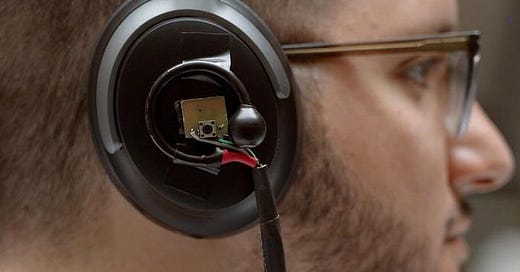AI-Powered Headphones Let You Hear One Person in a Crowded Room
AI-Powered Noise-Cancelling Headphones
Subscribe to Genomely for the latest discoveries and in-depth analyses in your inbox.
Thank you to our subscribers for your continued support and passion for science!
Artificial intelligence (AI) is transforming the capabilities of noise-cancelling headphones, making them more effective and versatile than ever before. Recent innovations have led to the creation of AI-powered headphones that cancel out ambient noise and enhance the ability to focus on specific voices in crowded environments. This new technology holds significant promise for improving communication in noisy settings, aiding individuals with hearing impairments, and potentially reshaping our daily auditory experiences.
The Evolution of Noise-Cancelling Technology
Noise-canceling headphones have been around for decades, primarily serving to reduce unwanted ambient sounds by using active noise control (ANC). Traditional ANC technology generates sound waves that are the exact negative (antiphase) of the ambient noise, thereby canceling it. While effective to an extent, traditional noise-canceling headphones have limitations, particularly in distinguishing between various types of noises and in environments with dynamic soundscapes.
The integration of AI into these devices marks a significant leap forward. AI-powered noise-canceling headphones leverage advanced algorithms and machine learning to adapt to real-time environments and user needs. This allows for a more nuanced and effective noise-canceling experience, making it possible to filter out specific sounds while amplifying others selectively.
The Breakthrough: AI-Powered Selective Listening
Recently, researchers at the University of Washington, Seattle, developed AI-powered headphones that can isolate and amplify the voice of a single person in a crowded environment by visually identifying the speaker.
These AI headphones have cameras and advanced AI algorithms that recognize and focus on the speaker's face. The headphones can enhance the speaker's voice while suppressing background noise, allowing the wearer to hear the person clearly, even in noisy surroundings. This technology relies on visual and auditory data processing, utilizing computer vision to track the speaker and sophisticated audio filtering techniques to isolate their voice.
Applications and Implications
The potential applications for AI-powered selective listening are vast and varied. Here are some promising and impactful areas for this research:
Hearing Aids: Understanding speech in noisy environments can be a significant challenge for individuals with hearing impairments. AI-powered selective listening can make it easier for these individuals to engage in conversations, improving their quality of life and social interactions.
Professional Settings: Focusing on a single speaker can enhance communication and productivity in busy workplaces, such as open-plan offices or construction sites. This technology could be particularly beneficial in meetings or collaborative environments where clear communication is crucial.
Consumer Electronics: For general consumers, AI-powered headphones could revolutionize personal audio experiences. Whether in a busy café, a noisy commute, or a crowded event, these headphones can provide a more enjoyable and immersive listening experience by allowing users to focus on the sounds they want to hear.
Safety and Security: In environments where situational awareness is critical, such as for law enforcement or security personnel, focusing on specific sounds can enhance operational effectiveness and safety.
Technological Challenges and Considerations
While the potential benefits of AI-powered selective listening are immense, some several challenges and considerations need to be addressed:
Privacy Concerns: Using cameras and visual tracking raises privacy issues. Ensuring that these devices are used ethically and that users' privacy is protected will be crucial for widespread adoption.
Data Security: As with any device that collects and processes personal data, ensuring robust data security measures is essential to protect users' information from potential breaches.
Accuracy and Reliability: The effectiveness of AI algorithms in accurately identifying and isolating specific voices will be a crucial factor in the success of these headphones. Continuous advancements in machine learning and AI will be necessary to improve accuracy and reliability.
Cost and Accessibility: Making these advanced headphones affordable and accessible to many users will be necessary for their widespread adoption. Balancing advanced features with cost-effective production will be a challenge for manufacturers.
The Future of AI-Powered Audio Technology
The integration of AI into noise-canceling headphones is just the beginning of what could be a broader trend of AI-enhanced audio devices. As AI technology continues to evolve, we expect to see further innovations pushing the boundaries of what is possible in personal audio and hearing assistance.
Future developments include even more sophisticated voice recognition and enhancement capabilities, improved battery life and energy efficiency, and seamless integration with other smart devices and ecosystems. Additionally, as AI becomes more adept at understanding and processing natural language, these headphones could offer real-time language translation and other advanced features.
References
https://www.washington.edu/news/2024/05/23/ai-headphones-noise-cancelling-target-speech-hearing/
https://www.popsci.com/technology/ai-headphones-noise-cancelling/





